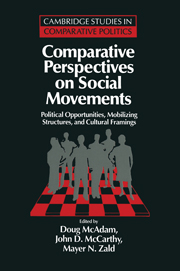 Comparative Perspectives on Social Movements
Comparative Perspectives on Social Movements Book contents
- Frontmatter
- Contents
- Biographical sketches of contributors
- Preface
- Introduction: Opportunities, mobilizing structures, and framing processes – toward a synthetic, comparative perspective on social movements
- PART I POLITICAL OPPORTUNITIES
- PART II MOBILIZING STRUCTURES
- PART III FRAMING PROCESSES
- 11 Culture, ideology, and strategic framing
- 12 Framing political opportunity
- 13 Accessing public, media, electoral, and governmental agendas
- 14 Media discourse, movement publicity, and the generation of collective action frames: Theoretical and empirical exercises in meaning construction
- 15 The framing function of movement tactics: Strategic dramaturgy in the American civil rights movement
- Notes
- References
- Index
13 - Accessing public, media, electoral, and governmental agendas
Published online by Cambridge University Press: 05 June 2012
- Frontmatter
- Contents
- Biographical sketches of contributors
- Preface
- Introduction: Opportunities, mobilizing structures, and framing processes – toward a synthetic, comparative perspective on social movements
- PART I POLITICAL OPPORTUNITIES
- PART II MOBILIZING STRUCTURES
- PART III FRAMING PROCESSES
- 11 Culture, ideology, and strategic framing
- 12 Framing political opportunity
- 13 Accessing public, media, electoral, and governmental agendas
- 14 Media discourse, movement publicity, and the generation of collective action frames: Theoretical and empirical exercises in meaning construction
- 15 The framing function of movement tactics: Strategic dramaturgy in the American civil rights movement
- Notes
- References
- Index
Summary
Social movements are involved in struggles over meaning as they attempt to influence public policy. An essential task in these struggles is to frame social problems and injustices in a way that convinces a wide and diverse audience of the necessity for and utility of collective attempts to redress them. Movement frames typically embody two essential components: the diagnostic element, or the definition of the problem and its source; and the prognostic element, the identification of an appropriate strategy for redressing the problem (Snow and Benford 1988). Movements usually lack the political and/or material resources necessary for routine access to political decision-makers and therefore must rely primarily on “outsider” strategies to draw the attention of publics and policymakers to the problems they wish to have resolved. Lipsky (1968) identified a fundamental logic of movement strategy as a conscious attempt to draw third parties into the conflict in order to raise the stakes in the conflict and bring favorable pressure to bear on the policy process. While movements' ultimate targets are typically policymakers, movements must mobilize people and resources within the wider society in order to influence this authoritative elite. These third parties include both the mass public and the reference elites, the people with whom the authoritative elite interacts and consults. A major tool in this process is the mass media, which can reach a much larger audience than social movement actors can reach directly.
- Type
- Chapter
- Information
- Comparative Perspectives on Social MovementsPolitical Opportunities, Mobilizing Structures, and Cultural Framings, pp. 291 - 311Publisher: Cambridge University PressPrint publication year: 1996
- 84
- Cited by


